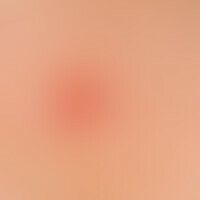Image diagnoses for "Plaque (raised surface > 1cm)"
570 results with 2865 images
Results forPlaque (raised surface > 1cm)

Lupus erythematosus tumidus L93.2
Lupus erythermatodes tumidus:chronic recurrent disease patternforseveral years. no itching, no other subjective complaints. significant improvement of symptoms under therapy with antimalarial drugs.

Erythroplasia queyrat D07.4

Basal cell carcinoma nodular C44.L
Basal cell carcinoma nodular: Slowly growing, symptomless, surface smooth lump, existing for several years; conspicuous bizarre vascular structure.

Acuminate condyloma A63.0
Condylomata acuminata. Small, brownish, partly confluent papules on the shaft of the penis.

Atopic dermatitis in infancy L20.8
Atopic dermatitis:chronic, recurrent itchy red spots and slightly raised red plaques on the cheeks and forehead of an 8-month-old girl; multiple, disseminated, sometimes crusty scratch excoriations are also visible.

Intertriginous psoriasis L40.84
Psoriasis intertriginosa: circumscribed, sharply defined, red, rough plaque with erosion and maceration as well as formation of a rhagade in the area of the rima ani. considerable symptoms (itching, especially after prolonged sitting or sporting activity) and resistance to therapy.
Remark: In this case a systemic therapy with fumaric acid ester is recommended.

Atopic hand dermatitis L20.8
Hand eczema atopic: previously known atopic eczema with variable course; the skin lesions on both palms have existed with varying intensity for several years.

Granuloma anulare disseminatum L92.0
Granuloma anulare disseminatum: non-painful, non-itching, disseminated, large-area plaques that appeared on the trunk and extremities of a 52-year-old patient. No diabetes mellitus. No other systemic diseases known.

Lichen planus exanthematicus L43.81
Lichen planus exanthematicus: for several months persistent, itchy, generalized, dense rash with emphasis on the trunk and extremities (face not affected); as single florescence a 0.1-0.2 cm large, rounded, brown to reddish-white papules and plaques with a verrucous surface appear.

Lupus erythematosus (overview) L93.-
Systemic lupus erythematosus. symmetrical, scaly plaques existing for weeks; disturbance of general condition with medium-high fever, rheumatoid complaints. emphasis on light-exposed areas. 10-year-old girl.

Acquired progressive lymphangioma D18.10
Lymphangioma progressive: large brownish-red plaques, which fray into small flat plaques at the edges. No complaints. We aregratefulto Dr. U. Ammanfor submitting this image.













